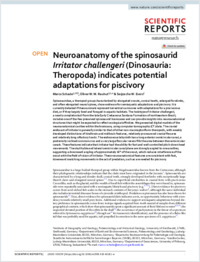Neuroanatomy of the spinosaurid Irritator challengeri (Dinosauria: Theropoda) indicates potential adaptations for piscivory
- Schade, Marco Institute of Geography and Geology, Palaeontology and Historical Geology, University of Greifswald, 17489, Greifswald, Germany - Department of Earth and Environmental Sciences, Palaeontology and Geobiology, Ludwig-Maximilians-Universität, 80333, München, Germany
- Rauhut, Oliver W. M. Department of Earth and Environmental Sciences, Palaeontology and Geobiology, Ludwig-Maximilians-Universität, 80333, München, Germany - Bayerische Staatssammlung für Paläntologie und Geologie, Staatliche Naturwissenschaftliche Sammlungen Bayerns (SNSB), 80333, München, Germany - GeoBioCenter, Ludwig-Maximilians-Universität, 80333, München, Germany
- Evers, Serjoscha W. Department of Geosciences, University of Fribourg, 17000, Fribourg, Switzerland
-
09.06.2020
Published in:
- Scientific Reports. - 2020, vol. 10, no. 1, p. 9259
English
Spinosauridae, a theropod group characterized by elongated snouts, conical teeth, enlarged forelimbs, and often elongated neural spines, show evidence for semiaquatic adaptations and piscivory. It is currently debated if these animals represent terrestrial carnivores with adaptations for a piscivorous diet, or if they largely lived and foraged in aquatic habitats. The holotype of Irritator challengeri, a nearly complete skull from the late Early Cretaceous Santana Formation of northeastern Brazil, includes one of the few preserved spinosaurid braincases and can provide insights into neuroanatomical structures that might be expected to reflect ecological affinities. We generated digital models of the neuroanatomical cavities within the braincase, using computer tomography (CT) data. The cranial endocast of Irritator is generally similar to that of other non-maniraptoriform theropods, with weakly developed distinctions of hindbrain and midbrain features, relatively pronounced cranial flexures and relatively long olfactory tracts. The endosseous labyrinth has a long anterior semicircular canal, a posteriorly inclined common crus and a very large floccular recess fills the area between the semicircular canals. These features indicate that Irritator had the ability for fast and well-controlled pitch-down head movements. The skull table and lateral semicircular canal plane are strongly angled to one another, suggesting a downward angling of approximately 45° of the snout, which reduces interference of the snout with the field of vision of Irritator. These neuroanatomical features are consistent with fast, downward snatching movements in the act of predation, such as are needed for piscivory.
- Faculty
- Faculté des sciences et de médecine
- Department
- Département de Géosciences
- Language
-
- English
- Classification
- Palaeontology
- License
-
License undefined
- Identifiers
-
- RERO DOC 328830
- DOI 10.1038/s41598-020-66261-w
- Persistent URL
- https://folia.unifr.ch/unifr/documents/308660
Statistics
Document views: 343
File downloads:
- pdf: 1386
